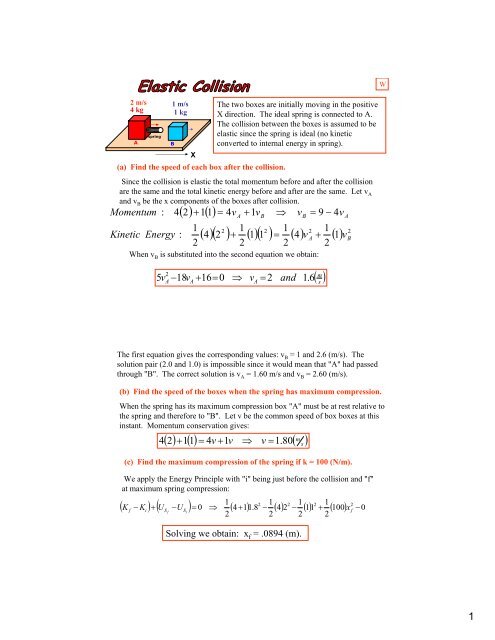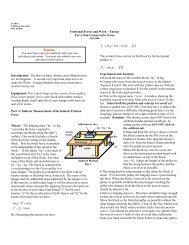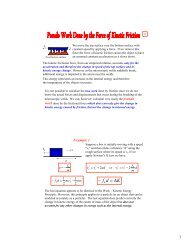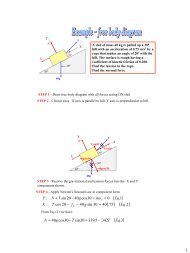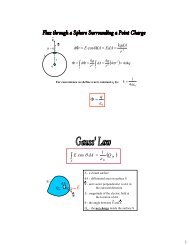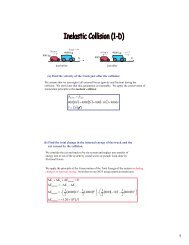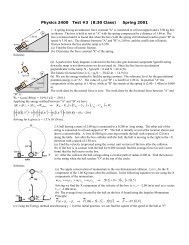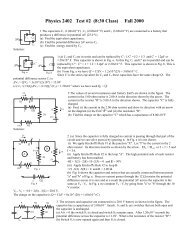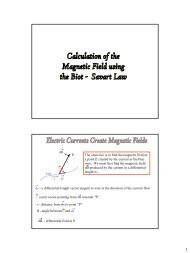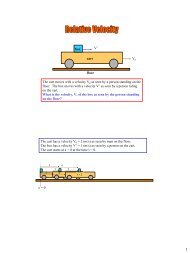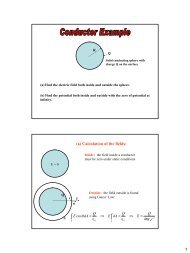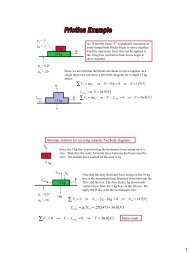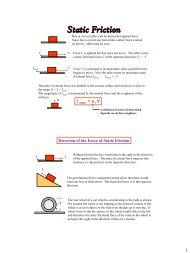One Dimensional Elastic Collision.
One Dimensional Elastic Collision.
One Dimensional Elastic Collision.
Create successful ePaper yourself
Turn your PDF publications into a flip-book with our unique Google optimized e-Paper software.
W<br />
2 m/s 1 m/s<br />
4 kg 1 kg<br />
A<br />
spring<br />
B<br />
X<br />
The two boxes are initially moving in the positive<br />
X direction. The ideal spring is connected to A.<br />
The collision between the boxes is assumed to be<br />
elastic since the spring is ideal (no kinetic<br />
converted to internal energy in spring).<br />
(a) Find the speed of each box after the collision.<br />
Since the collision is elastic the total momentum before and after the collision<br />
are the same and the total kinetic energy before and after are the same. Let v A<br />
and v B be the x components of the boxes after collision.<br />
Momentum<br />
Kinetic<br />
:<br />
Energy<br />
4<br />
( 2) + 1( 1)<br />
:<br />
1<br />
2<br />
= 4v<br />
A<br />
1<br />
2<br />
+ 1v<br />
B<br />
⇒<br />
1<br />
2<br />
= 9 − 4v<br />
1<br />
2<br />
( 4)( 2<br />
2 ) + ()( 1 1<br />
2 ) = ( 4) v<br />
2 + () 1 v<br />
2<br />
When v B is substituted into the second equation we obtain:<br />
5v 2 −18v<br />
+ 16=<br />
0 ⇒ v = 2 and 1. 6<br />
A<br />
A<br />
A<br />
v<br />
B<br />
A<br />
m<br />
( )<br />
s<br />
A<br />
B<br />
The first equation gives the corresponding values: v B = 1 and 2.6 (m/s). The<br />
solution pair (2.0 and 1.0) is impossible since it would mean that "A" had passed<br />
through "B". The correct solution is v A = 1.60 m/s and v B = 2.60 (m/s).<br />
(b) Find the speed of the boxes when the spring has maximum compression.<br />
When the spring has its maximum compression box "A" must be at rest relative to<br />
the spring and therefore to "B". Let v be the common speed of box boxes at this<br />
instant. Momentum conservation gives:<br />
( 2) + 11 ( ) = 4v + 1v<br />
⇒ v 1. 80( m<br />
)<br />
4 =<br />
(c) Find the maximum compression of the spring if k = 100 (N/m).<br />
We apply the Energy Principle with "i" being just before the collision and "f"<br />
at maximum spring compression:<br />
1<br />
2 1 2 1 2 1 2<br />
( K − K ) + ( U −U<br />
) = 0 ⇒ ( 4+<br />
11.8 ) − ( 4) 2 − () 11 + ( 100) x −0<br />
f<br />
i<br />
S f<br />
Si<br />
2<br />
Solving we obtain: x f = .0894 (m).<br />
2<br />
s<br />
2<br />
2<br />
f<br />
1
2 m/s 1 m/s<br />
4 1<br />
initial<br />
x<br />
final<br />
(d) Find the speed of both boxes when the spring<br />
compression is “x” (0 < x < .0894 m).<br />
v A<br />
and v B<br />
are the X components of the velocities when spring is compressed by “x”.<br />
4 2 11 = 4v + 1v<br />
⇒ v = 9 − 4v<br />
+ 1<br />
Momentum conservation: ( ) ( )<br />
A B B<br />
A<br />
Energy Conservation:<br />
ΔK<br />
1<br />
2<br />
A<br />
+ ΔK<br />
1<br />
2<br />
+ ΔU<br />
= 0<br />
1<br />
2<br />
2<br />
2<br />
2<br />
2<br />
2<br />
( 4) v − ( 4) 2 + () 1 v − () 11 + ( 100) x − 0 = 0<br />
A<br />
B<br />
s<br />
B<br />
1<br />
2<br />
1<br />
2<br />
2<br />
Substitution of v B<br />
from (1) into (2) gives:<br />
5v<br />
v<br />
A<br />
2<br />
A<br />
−18v<br />
18 ±<br />
=<br />
A<br />
+<br />
2<br />
( 16 + 25x<br />
)<br />
4 − 500x<br />
10<br />
2<br />
= 0<br />
(<br />
m<br />
s )<br />
While the spring is being compressed the<br />
speed of “A” is:<br />
v<br />
A<br />
18 +<br />
=<br />
4 − 500x<br />
10<br />
2<br />
(<br />
m<br />
s )<br />
1<br />
While the spring is returning to its<br />
uncompressed length the speed of “A” is:<br />
v<br />
A<br />
18 −<br />
=<br />
4 − 500x<br />
10<br />
2<br />
(<br />
m<br />
s )<br />
2<br />
Check of our solutions:<br />
As spring starts to compress we use (1) and x = 0: v A<br />
= 2.00 (m/s) ;v B<br />
= 9-4v A<br />
=1.00 (m/s).<br />
Just after spring returns to x = 0 we use (2): v A<br />
= 1.6 (m/s) ; v B<br />
= 9-4v A<br />
= 2.60 (m/s).<br />
When x = .0894 (m) we can use either (1) or (2): v A<br />
= 1.80 (m/s) and v B<br />
= (9-4v A<br />
)= 1.80 (m/s)<br />
2
Speeds calculated during the collision using:<br />
v<br />
A<br />
18 ±<br />
=<br />
4 − 500x<br />
10<br />
2<br />
(<br />
m<br />
s )<br />
2.8<br />
2.6<br />
after<br />
speed<br />
2.4<br />
2.2<br />
2<br />
1.8<br />
before<br />
A<br />
1.6<br />
1.4<br />
1.2<br />
1<br />
after<br />
B<br />
before<br />
0 0.02 0.04 0.06 0.08 0.1<br />
spring compression<br />
9<br />
8<br />
7<br />
total energy<br />
kinetic energy<br />
6<br />
energy<br />
5<br />
4<br />
3<br />
2<br />
1<br />
spring potential energy<br />
0<br />
0 0.02 0.04 0.06 0.08 0.1<br />
spring compression<br />
3
5 m/s<br />
2kg<br />
5 m/s<br />
2 kg<br />
A<br />
spring<br />
B<br />
We let “x” be the amount spring is compressed. For an elastic collision the total<br />
momentum and total energy ( kinetic + spring potential energy) are conserved<br />
momentum (kg.m/s)<br />
10<br />
8<br />
p a<br />
6<br />
4<br />
2<br />
0<br />
0<br />
-2<br />
0.02 0.04 0.06 0.08 0.1<br />
-4<br />
-6<br />
-8<br />
-10<br />
Energies (J)<br />
50<br />
45<br />
40<br />
35<br />
30<br />
p total 25<br />
20<br />
15<br />
10<br />
U s<br />
5<br />
p b<br />
0<br />
0 0.02 0.04 0.06 0.08 0.1<br />
X (m)<br />
X (m)<br />
K<br />
E total<br />
4


